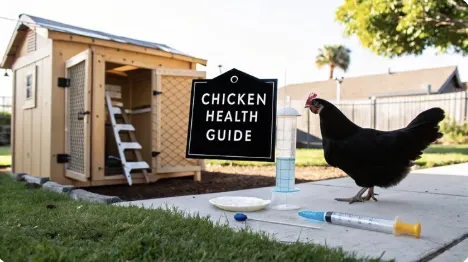
8 Common Backyard Chicken Illnesses, Symptoms, and Treatment
8 Common Backyard Chicken Illnesses Symptoms and Treatment
Raising backyard chickens is a rewarding journey, but keeping your flock healthy requires vigilance and a keen eye for detail. Spotting the first subtle signs of illness can mean the difference between a quick recovery and a serious flock-wide outbreak. As a chicken keeper, recognizing the signs of illness early is key, and an important part of this is learning how to differentiate by distinguishing viral vs bacterial infection symptoms.
This guide is your go-to resource for identifying and managing the most common backyard chicken illnesses symptoms and treatment protocols. We will provide clear, actionable checklists and practical steps to help you become a confident poultry health detective. You'll learn to recognize the specific signs of major health issues, from respiratory distress and digestive blockages to parasitic infections and viral diseases.
We’ve structured this roundup to be a practical field guide, not just a list. Each section details a specific illness, outlines its tell-tale symptoms, and provides concrete treatment options you can implement. Our goal is to empower you with the knowledge needed to maintain a thriving, productive flock. Let's dive in and learn how to keep your feathered friends happy and healthy.
1. Coccidiosis - Intestinal Parasitic Infection
Coccidiosis is a highly common and potentially lethal intestinal disease caused by microscopic protozoan parasites called Eimeria. These parasites invade and damage the intestinal lining of chickens, severely hindering their ability to absorb nutrients. While it most frequently affects young chicks between three and six weeks of age, older birds experiencing stress or with compromised immune systems are also susceptible. The parasite oocysts (eggs) are shed in the droppings of infected birds and thrive in warm, wet conditions, making clean coop management essential.
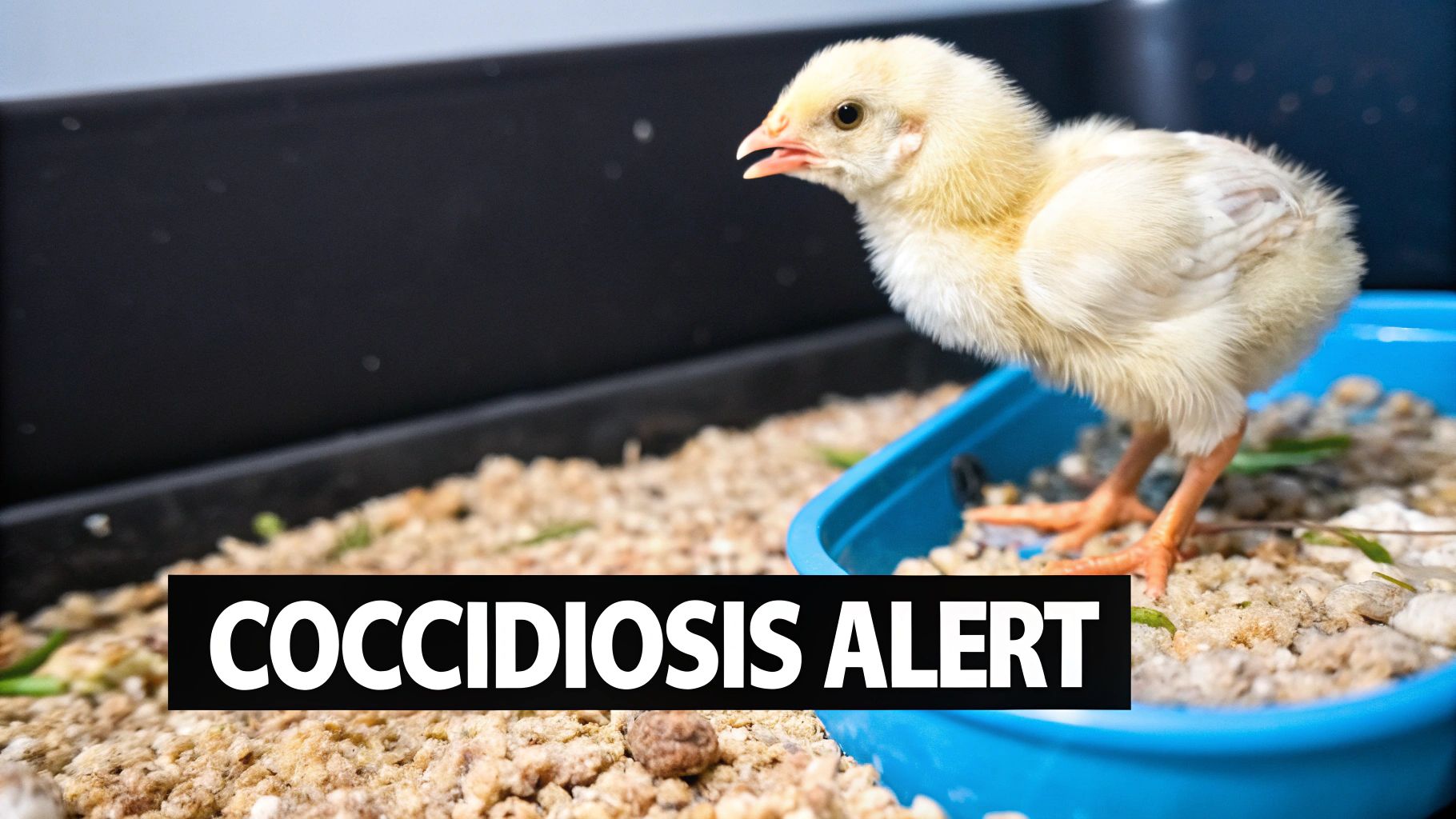
This disease is a prime example of why understanding common backyard chicken illnesses, their symptoms, and treatment is crucial for any flock owner. A swift response can mean the difference between life and death for your birds.
Symptoms to Watch For
Identifying coccidiosis early is key to successful treatment. Look for a combination of these clinical signs, especially in younger birds:
Bloody or mucus-filled droppings: This is the most classic and alarming symptom.
Lethargy and listlessness: Infected chicks will appear weak, tired, and may huddle together.
Pale comb and wattles: Caused by anemia from internal bleeding.
Ruffled, unkempt feathers.
Loss of appetite and weight loss.
Hunched posture with drooping wings.
Treatment and Prevention Strategies
Immediate action is necessary at the first sign of symptoms. Isolate the affected bird(s) to prevent further spread and begin treatment.
Actionable Tip: Keep Corid (amprolium) in your chicken first-aid kit. At the first sign of bloody droppings, administer it in the flock's only water source for 5-7 days according to package directions. Amprolium works by blocking the parasite's ability to utilize thiamine, effectively starving it.
For prevention, focus on management:
Keep the brooder and coop dry. Wet bedding is a breeding ground for Eimeria oocysts.
Avoid overcrowding. This reduces stress and limits the concentration of parasites in the environment.
Use medicated chick starter. This feed contains a low-dose coccidiostat to help chicks build immunity safely.
Quarantine new birds. Always keep new additions separate for at least 30 days to monitor for signs of illness.
Support recovery. After treatment, provide electrolytes and probiotics in the water to help restore gut health.
2. Bumblefoot - Bacterial Foot Infection
Bumblefoot, technically known as pododermatitis, is a common bacterial infection of a chicken's foot pad. It typically begins when bacteria, often Staphylococcus aureus, enter a small cut, scrape, or puncture on the bottom of the foot. This can be caused by a splinter, a hard landing from a high roost, or walking on rough surfaces. The infection forms a pus-filled abscess, which hardens into a distinctive black scab or "kernel" on the foot pad, causing pain, swelling, and lameness.
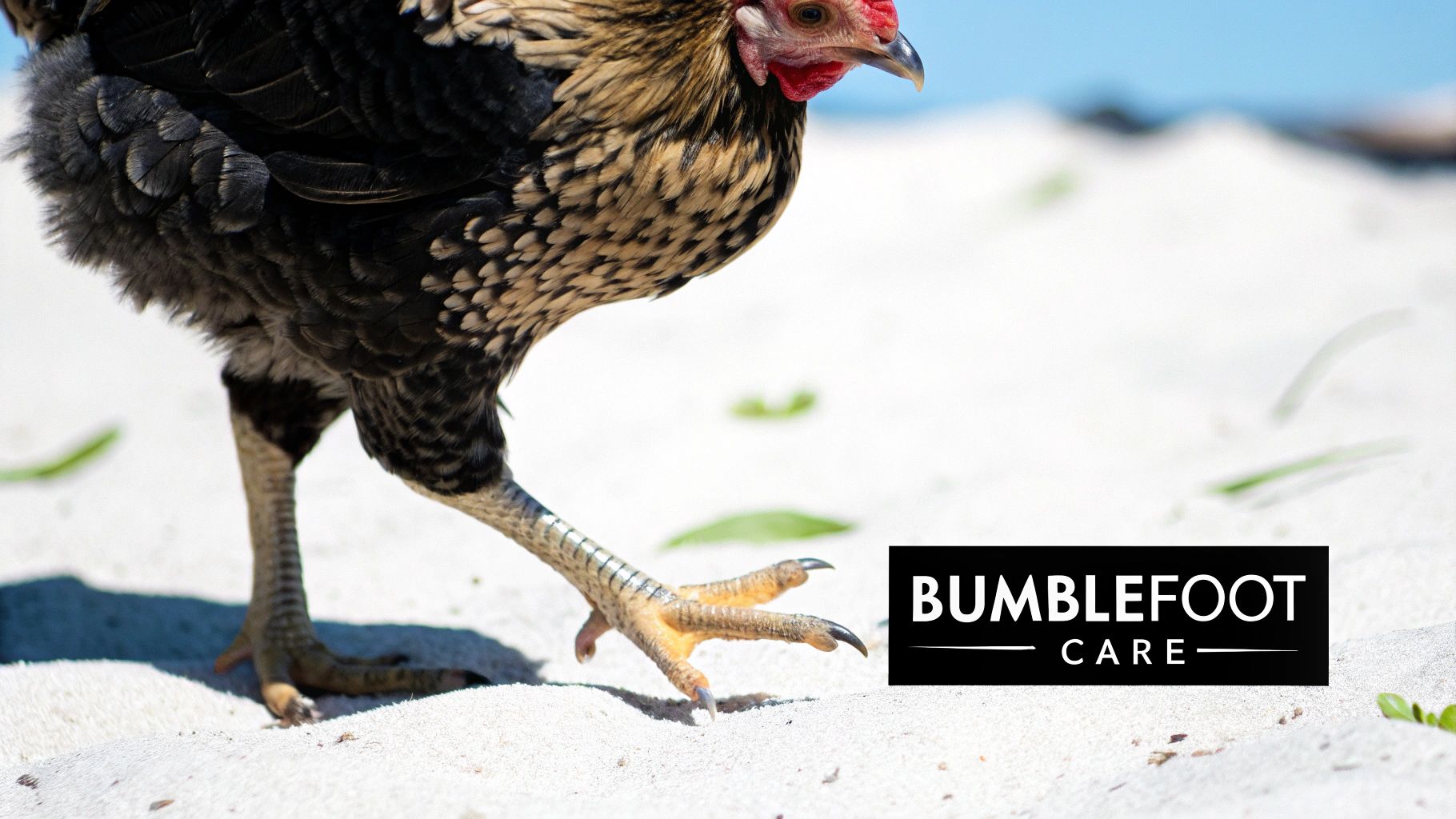
Left untreated, the infection can spread up the leg and into the bone, becoming systemic and potentially fatal. Regularly checking your flock's feet is a simple but critical part of understanding and preventing common backyard chicken illnesses, and swift treatment can resolve most cases of bumblefoot. Heavier breeds like Orpingtons are particularly susceptible due to the increased pressure on their feet.
Symptoms to Watch For
Bumblefoot is usually easy to spot if you know what to look for. Regular health checks are the best way to catch it early.
Limping or reluctance to walk: The bird may favor one foot.
Swelling: The foot pad and sometimes the entire foot will appear puffy and red.
A distinct black scab: A round, black dot or plug will be visible on the bottom of the foot pad.
Heat: The affected area may feel warm to the touch.
Lethargy or loss of appetite in severe cases where the infection has spread.
Treatment and Prevention Strategies
Minor cases can often be managed at home, but severe infections may require a veterinarian. Isolate the affected chicken in a clean, dry space with soft bedding to begin treatment and prevent the wound from getting dirty.
Actionable Tip: To treat bumblefoot, soak the affected foot in a warm Epsom salt solution for 15-20 minutes to soften the scab. Using sterile tweezers, gently work to remove the black plug. Once removed, flush the wound with a saline solution, apply an antibiotic ointment, and wrap the foot securely with a self-adherent bandage. Change the bandage daily until it has healed.
For prevention, focus on your coop and run environment:
Lower roosting bars. High roosts force birds to make hard landings, increasing the risk of foot injuries. Bars should be no higher than 18-24 inches for heavy breeds.
Provide soft bedding. Use sand, deep pine shavings, or straw in the coop and run to cushion their feet.
Keep the environment clean and dry. This minimizes the bacteria your chickens are exposed to.
Perform regular foot checks. Routinely inspect the bottom of each chicken's feet for cuts, scrapes, or early signs of infection.
For a visual guide on the procedure, this video provides a detailed walkthrough of bumblefoot treatment:
3. Respiratory Diseases - Infectious Bronchitis and Newcastle Disease
Respiratory diseases are a group of highly contagious viral or bacterial infections that can spread through a flock with alarming speed. Common culprits include Infectious Bronchitis and Newcastle Disease, both caused by viruses that attack the chicken's respiratory system. These illnesses are often transmitted through airborne droplets from sneezing or coughing, as well as through contaminated equipment, feed, and water. A seemingly minor cough can quickly escalate into a flock-wide crisis, making these diseases a serious concern for backyard keepers.
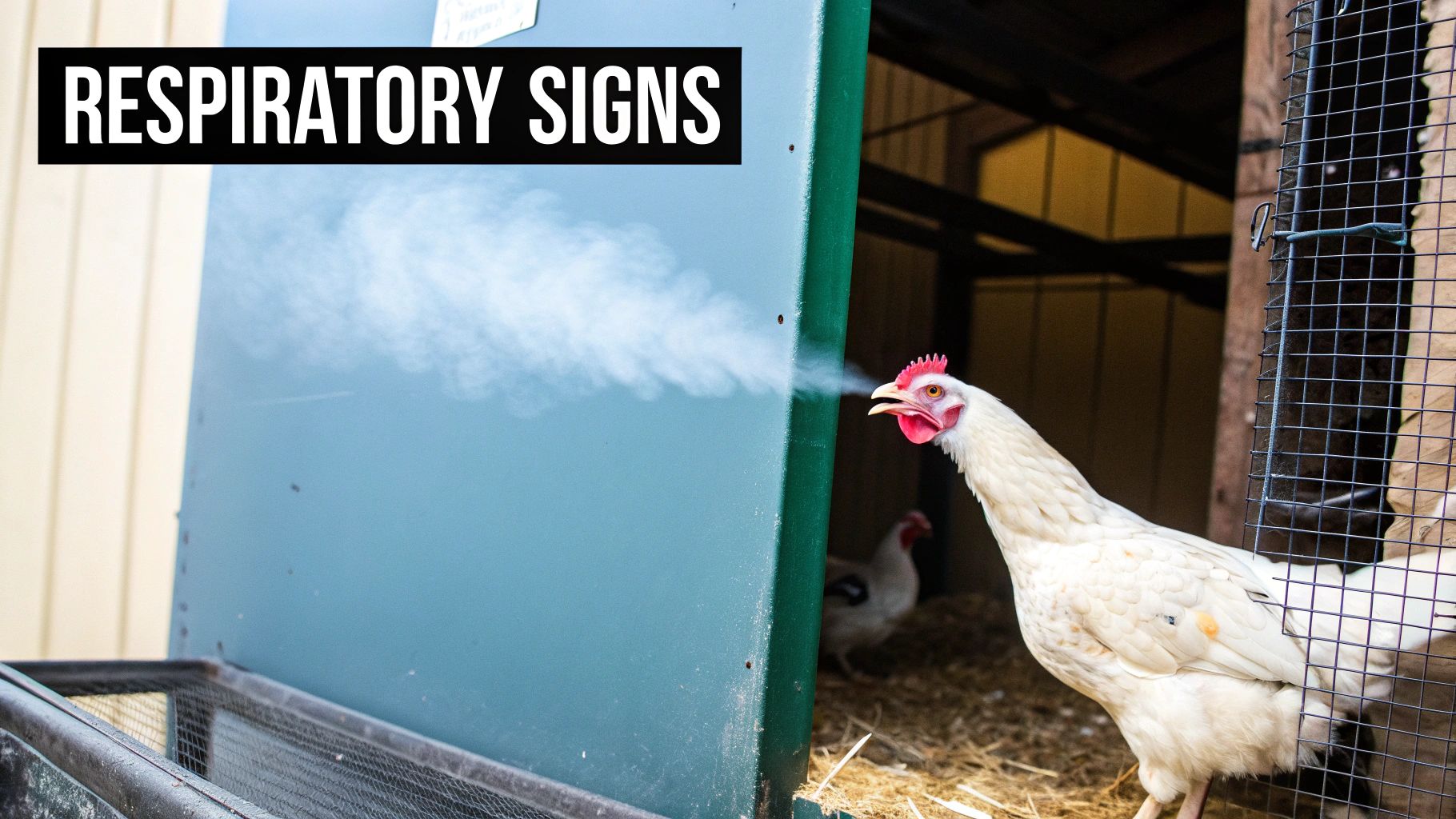
Understanding the signs of these common backyard chicken illnesses, their symptoms, and treatment options is vital for protecting your flock's health. The rapid transmission rate of respiratory infections means that early detection and immediate quarantine are non-negotiable for containment.
Symptoms to Watch For
Respiratory symptoms can be similar across different diseases, so look for a cluster of these signs:
Sneezing, coughing, and gurgling sounds (rales).
Discharge from the eyes or nostrils.
Swelling of the face, sinuses, or wattles.
Gasping or open-mouthed breathing.
Lethargy and decreased appetite.
A sudden drop in egg production or thin-shelled, misshapen eggs.
In severe cases, like with virulent Newcastle Disease, twisted necks or paralysis may occur.
Treatment and Prevention Strategies
Since most common respiratory diseases are viral, there is no direct cure; treatment focuses on supportive care and preventing secondary bacterial infections.
Actionable Tip: Immediately isolate any bird showing respiratory symptoms. Provide a warm, draft-free environment and add electrolytes and a vitamin supplement to their water to support their immune system. This supportive care can help them fight off the virus.
For prevention, biosecurity is your best defense:
Strict quarantine. All new birds must be kept completely separate from your main flock for at least 30 days.
Good ventilation. Ensure your coop has excellent airflow without being drafty to reduce airborne pathogen concentration.
Vaccinate. If you live in an area where diseases like Newcastle are prevalent, talk to a vet about a vaccination schedule.
Minimize stress. Overcrowding, poor nutrition, and bullying can weaken a chicken's immune system, making them more susceptible.
Cleanliness is key. Regularly clean and disinfect feeders, waterers, and coop surfaces to reduce the viral load in the environment. For those focused on egg-laying, maintaining a healthy environment is a core part of raising chickens for eggs successfully.
4. Marek's Disease - Viral Neurological Disorder
Marek's Disease is a highly contagious and often fatal viral infection caused by a herpesvirus. It is one of the most common and devastating diseases in backyard flocks, primarily affecting young chickens between 12 and 25 weeks of age. The virus spreads easily through feather dander shed by infected birds, which can remain infectious in the environment for months. It attacks the nervous system and internal organs, causing paralysis and tumors.
Because there is no cure, understanding Marek's Disease is a critical part of knowing about common backyard chicken illnesses, their symptoms, and treatment options, as prevention is the only effective strategy. Once a flock is infected, the virus is present for life.
Symptoms to Watch For
Marek's presents in several forms, but the "classic" form involving paralysis is most recognizable. Symptoms often appear suddenly in seemingly healthy young birds.
Paralysis: This is the hallmark sign, often affecting one leg stretched forward and the other back, known as "Marek's splits." Wing or neck paralysis can also occur.
Weight loss: Birds may waste away despite having an appetite.
Grey or irregularly shaped pupil: This is indicative of ocular Marek's, which can lead to blindness.
Lethargy and general unthriftiness.
Tumors: Internal tumors (visceral form) can lead to organ failure and are often only found during a necropsy.
Treatment and Prevention Strategies
There is no treatment for Marek's Disease; therefore, prevention through vaccination and biosecurity is paramount. Supportive care can be offered to affected birds, but recovery is rare, and they will remain carriers.
Actionable Tip: The most effective prevention is to purchase day-old chicks that have been vaccinated for Marek's at the hatchery. This single vaccination, given on the day of hatch, is highly effective at preventing tumor formation and paralysis for the bird's life.
For prevention and management, focus on these key areas:
Vaccinate: Always source chicks from a reputable hatchery that offers the Marek's vaccine. It is the best defense available.
Strict Biosecurity: Since the virus spreads via dander, limit visitors and avoid sharing equipment with other flock owners.
All-In, All-Out System: Avoid mixing birds of different ages. Raise new chicks separately from your adult flock for as long as possible.
Manage Dust: Regularly clean the coop to reduce infectious feather dander buildup.
Supportive Care: For a paralyzed bird, ensure it has deep, soft bedding and easy access to low-profile food and water dishes. Humane euthanasia is often the kindest option for severely affected birds to prevent suffering.
5. Egg Binding - Reproductive Emergency
Egg binding is a serious and potentially fatal reproductive condition where a hen is unable to pass an egg. The egg becomes physically stuck in her oviduct, blocking her system. This emergency is most common in young pullets laying their first eggs, overweight hens, or birds deficient in calcium. Without intervention, an egg-bound hen can die from shock, infection, or internal organ damage within 24 to 48 hours.
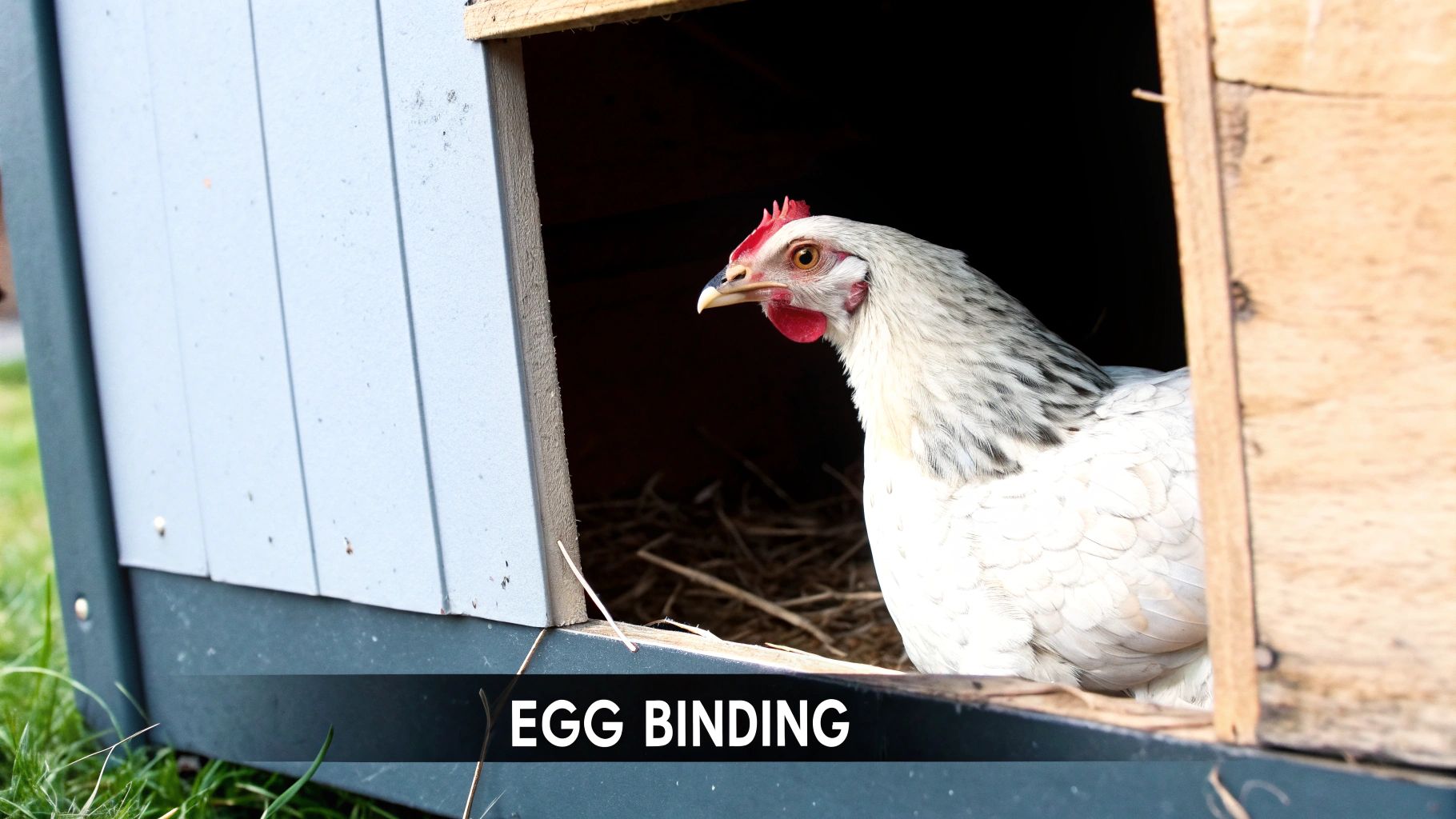
Understanding the signs of this condition is a critical part of knowing about common backyard chicken illnesses, symptoms, and treatment. A quick and calm response can save your hen's life, as seen in cases where a warm bath and gentle massage help a young Bantam pass her first oversized egg.
Symptoms to Watch For
An egg-bound hen will appear distressed and act very differently from normal. Watch closely for these specific signs:
Frequent straining: The hen may look constipated, visiting the nest box repeatedly without laying.
"Penguin walk": Walking with an unusually upright, waddling posture due to the pressure.
Lethargy and loss of appetite: She will be listless, uninterested in food or water.
Sitting fluffed up with a droopy tail and wings.
A swollen, soft abdomen near the vent.
Watery droppings or a complete lack of droppings.
Treatment and Prevention Strategies
Time is of the essence. Immediately isolate the hen in a warm, quiet, and dark space like a crate or dog kennel to reduce stress.
Actionable Tip: Create a "spa" for your hen by placing her in a tub of warm water (Epsom salts optional) for 15-20 minutes. The warmth and humidity can relax her muscles. Afterward, gently apply a water-based lubricant around her vent and carefully massage her abdomen in a downward motion toward the vent.
For prevention, focus on diet and genetics:
Provide adequate calcium. Always offer a separate dish of crushed oyster shell or eggshells so hens can self-regulate their intake.
Ensure proper nutrition. A balanced layer feed is crucial for reproductive health. Explore how to create the right nutritional profile for your flock with this guide on how to make chicken feed.
Avoid obesity. Don't overdo high-calorie treats like corn and scratch grains.
Manage stress. Keep the coop clean, provide ample space, and discourage bullying.
Seek help. If the egg has not passed within a few hours of home treatment, contact an avian veterinarian immediately.
6. Fowl Pox - Viral Skin and Respiratory Infection
Fowl Pox is a slow-spreading viral disease caused by a poxvirus, presenting in two distinct forms. The more common "dry pox" causes wart-like lesions on unfeathered areas of the skin, like the comb, wattles, and legs. The more severe "wet pox" creates lesions in the mouth, throat, and trachea, which can impede breathing and eating. The virus is primarily transmitted through mosquito bites, but also through direct contact with infected birds or contaminated surfaces.
While the dry form is often mild and resolves on its own, wet pox can be fatal, making it an important part of understanding common backyard chicken illnesses, their symptoms, and treatment options. The disease is most prevalent during warmer, bug-heavy months.
Symptoms to Watch For
The signs of Fowl Pox vary depending on whether the bird has the dry or wet form. A chicken can sometimes have both simultaneously.
Dry Pox: Small, greyish blisters on the comb, wattles, face, and eyelids that develop into larger, wart-like yellow or black scabs.
Wet Pox: Yellowish-white, cheesy lesions (cankers) inside the mouth, on the tongue, or in the throat.
Loss of appetite and reduced water intake, especially with wet pox due to oral pain.
Difficulty breathing or gasping if lesions obstruct the airway.
Swollen eyelids that may seal the eyes shut.
Drop in egg production.
Treatment and Prevention Strategies
Since Fowl Pox is a virus, there is no direct cure; treatment focuses on supportive care and preventing secondary bacterial infections until the virus runs its course, typically in two to four weeks.
Actionable Tip: For dry pox lesions, gently apply a mild antiseptic solution like Betadine or Vetericyn to the scabs to prevent secondary bacterial infection. Do not attempt to pick the scabs off, as this can spread the virus. Let them fall off naturally.
Key prevention and management steps include:
Control mosquitoes. Eliminate standing water and use coop-safe mosquito traps or repellents, as they are the primary vectors.
Isolate affected birds immediately. This prevents the spread through direct contact and shared equipment.
Provide soft, palatable food. For birds with wet pox, offer a mash or scrambled eggs to encourage eating.
Support the immune system. Add vitamin supplements and electrolytes to the water to help birds fight the virus.
Consider vaccination. If Fowl Pox is common in your area, a wing-web vaccination can provide effective, long-term protection.
7. Worm Infestations - Internal Parasites
Internal parasitic worms are a pervasive issue in backyard flocks, especially those that free-range or have access to outdoor pasture. Common culprits include roundworms, cecal worms, capillary worms, and tapeworms. These parasites reside in the chicken's digestive tract, stealing vital nutrients and causing internal damage that can lead to poor health, reduced egg laying, and vulnerability to other infections. A heavy worm load can be debilitating, making it a critical aspect of managing common backyard chicken illnesses.
Unlike acute diseases, worm infestations often build up slowly, gradually degrading the health of the entire flock. Proactive monitoring and management are essential to prevent a minor issue from becoming a major health crisis that impacts growth and productivity.
Symptoms to Watch For
The signs of a worm infestation can be subtle at first, becoming more obvious as the parasite load increases. Early detection is key to preventing severe health decline:
Weight loss or poor growth despite a good appetite.
Reduced egg production or smaller, poor-quality eggs.
Diarrhea, which can sometimes be foamy or pale.
Pale comb and wattles due to anemia.
Listlessness and lethargy.
Visible worms in droppings or, in severe cases, from the vent.
Treatment and Prevention Strategies
A strategic approach combining treatment and prevention is the most effective way to control internal parasites. Isolate any bird showing severe symptoms.
Actionable Tip: Keep a dewormer like Safe-Guard Aquasol (fenbendazole) on hand. It is FDA-approved for poultry, treats the most common worms, and has no egg withdrawal period, making it a convenient and effective treatment. Administer it through the drinking water as directed.
For long-term prevention, focus on coop and pasture management:
Perform regular fecal exams. A veterinarian can perform a fecal float test to identify the specific type and number of worm eggs present, guiding your treatment plan.
Practice rotational grazing. Moving your flock to fresh pasture regularly helps break the parasite life cycle, as eggs are shed in droppings.
Keep the coop and run clean and dry. Parasite eggs thrive in moist, dirty environments.
Avoid overcrowding. Fewer birds in a given space reduce the concentration of parasite eggs and lower transmission rates.
Provide supportive care. After deworming, offer probiotics and vitamins to help restore gut health and boost the immune system.
8. Sour Crop (Crop Stasis) - Digestive System Blockage
Sour crop, medically known as crop stasis, is a digestive issue where the crop, a small pouch at the base of the chicken's neck, fails to empty properly. The trapped food begins to ferment, creating a yeast-like, sour-smelling environment that can lead to fungal infections and systemic illness. This condition can be caused by various factors, including consuming tough, long grasses, swallowing foreign objects, overeating scratch grains, or an underlying illness that slows down the digestive system.
This ailment is a clear sign that something is amiss with a chicken's digestion and is another reason why a solid understanding of common backyard chicken illnesses, their symptoms, and treatment is essential for flock health. Quick intervention can often resolve the issue without veterinary care.
Symptoms to Watch For
The signs of sour crop are distinct and often focused on the bird's upper digestive tract. Look for these key indicators:
A swollen, squishy, or water-balloon-like crop that does not empty overnight.
A foul or sour, yeasty odor coming from the chicken's beak.
Loss of appetite and a general disinterest in food or water.
Lethargy and listlessness.
Weight loss over a period of days.
Fluid discharge from the mouth or nostrils.
Treatment and Prevention Strategies
If you suspect sour crop, it's important to act immediately. Isolate the affected chicken to monitor its food and water intake closely and to prevent bullying from other flock members.
Actionable Tip: Gently massage the crop in a downward motion towards the stomach for several minutes, multiple times a day. This can help break up the impacted material and encourage it to pass through the digestive system. You can give the chicken a few drops of olive oil to help lubricate the contents.
For prevention, good management is key:
Limit treats. Keep treats, especially scratch grains, to no more than 10% of their total diet to prevent gorging.
Ensure grit is always available. Insoluble grit is crucial for grinding up food in the gizzard, which aids proper digestion.
Keep pastures mowed. Long, fibrous grass is a common cause of crop impaction, which can lead to sour crop.
Maintain a clean environment. A well-maintained coop and run reduce the chances of birds ingesting foreign materials. Find out more by learning about setting up a chicken coop for beginners.
Seek veterinary help. If the crop does not empty after 24-48 hours of home treatment or the bird's condition worsens, contact a vet immediately.
Common Backyard Chicken Illnesses: Symptoms & Treatments Comparison

Your Next Steps for a Resilient Flock
Navigating the world of backyard poultry health can seem daunting, but by familiarizing yourself with these common backyard chicken illnesses symptoms and treatment options, you have taken a monumental step toward becoming a proactive and confident flock keeper. This guide has equipped you to recognize the subtle signs of distress, from the watery eyes of a respiratory infection to the labored stance of egg binding, and empowered you to take swift, effective action.
The recurring theme across all these ailments is the profound power of prevention. A vigilant, observant chicken keeper is the first and best line of defense against disease. Mastering these concepts is not just about treating sickness; it's about cultivating an environment where your flock can thrive, minimizing stress, and maximizing their natural resilience.
Building Your Flock Health Action Plan
True flock stewardship goes beyond reacting to problems. It involves creating a system that prevents them from occurring in the first place. Here are your actionable next steps to build a robust health and wellness plan for your chickens:
Establish a Biosecurity Baseline: Your single most effective tool is preventing pathogens from ever reaching your flock. Implement simple but strict protocols, such as dedicated coop footwear, quarantining new birds for at least 30 days, and discouraging wild birds from accessing feeders and waterers.
Create a "Well-Chicken" Profile: Take time to observe your flock when they are healthy and active. Note their normal posture, energy levels, droppings, and vocalizations. This mental and physical baseline will make any deviation, no matter how small, immediately stand out.
Assemble a First-Aid Kit: Don't wait for an emergency. Prepare a dedicated kit with essential supplies like electrolytes, poultry-safe wound spray (like Vetericyn), Epsom salts for soaking, liquid calcium for egg binding, and medication like Corid for coccidiosis outbreaks. Having these on hand can save precious time.
Sourcing Medications and Professional Help
When home remedies and preventative care aren't enough, you may need to source specific medications. To ensure your flock receives the necessary treatments, it's beneficial to know how to safely order pet meds online from reputable suppliers. Always consult with a veterinarian experienced with poultry before administering any new medication to confirm the diagnosis, dosage, and withdrawal times for eggs and meat. Developing a relationship with a local vet before you need them is a critical step many new keepers overlook.
By integrating these practices into your daily routine, you transform from a chicken owner into a true flock guardian. Your sharpened observation skills and preventative strategies will not only save you from future heartache and expense but will also ensure your birds live long, healthy, and productive lives. You are now better prepared to face the challenges of poultry-keeping head-on, ensuring your homestead remains a source of joy, nourishment, and connection.
Ready to take your homesteading skills to the next level? The Grounded Homestead offers comprehensive guides, practical courses, and a supportive community dedicated to helping you master everything from coop design to advanced flock health management. Visit The Grounded Homestead to access resources that will help you build a truly resilient and thriving backyard ecosystem.


Facebook
Instagram
X
Youtube